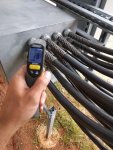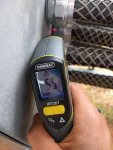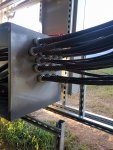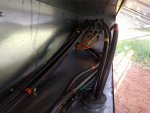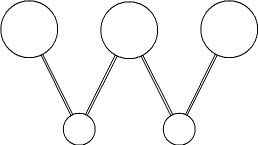caprilister
Member
- Location
- Atlanta, GA
I have a solar PV system with the output of 3 AC combiners going through a metal transition box into their respective Service Disconnects.
Output of the combiners goes to 3 current carrying conductors 600 kcmil CU + #3 CU neutral + #3 CU GND that penetrate the side of the transition box through a 1" cord grip. Continuous load for each combiner is 300A.
When the production of the solar array (and AC output of inverters) goes up, the cord grips heat up to 73 degrees Celsius. The temperature fluctuates quite rapidly with PV production, which leads me to believe that there is an issue with magnetic field heating up the metal fitting. Wire is USE-2 600V and there's a rubber grommet in the cord grip so only rubber is touching the wire coating. The coating of the wire not hot.
The terminations at disconnects are at constant 40 degrees.
Fitting temperature at 150A output was only 28 degrees on a cloudy day.
On a clear sky, at 250A output the temperature was 65 C.
Does anyone have any idea what would cause the heating of the fitting? And as long as the temperature stays below the wire rating (90 C) is there anything I should be worried about, especially since the grommet is rated for 105 C and the wire coating 90 so there is a good bit of buffer before those materials start to deteriorate from the heat.
Attached some photos of the arrangement and measurements.
Thanks for your help!
Output of the combiners goes to 3 current carrying conductors 600 kcmil CU + #3 CU neutral + #3 CU GND that penetrate the side of the transition box through a 1" cord grip. Continuous load for each combiner is 300A.
When the production of the solar array (and AC output of inverters) goes up, the cord grips heat up to 73 degrees Celsius. The temperature fluctuates quite rapidly with PV production, which leads me to believe that there is an issue with magnetic field heating up the metal fitting. Wire is USE-2 600V and there's a rubber grommet in the cord grip so only rubber is touching the wire coating. The coating of the wire not hot.
The terminations at disconnects are at constant 40 degrees.
Fitting temperature at 150A output was only 28 degrees on a cloudy day.
On a clear sky, at 250A output the temperature was 65 C.
Does anyone have any idea what would cause the heating of the fitting? And as long as the temperature stays below the wire rating (90 C) is there anything I should be worried about, especially since the grommet is rated for 105 C and the wire coating 90 so there is a good bit of buffer before those materials start to deteriorate from the heat.
Attached some photos of the arrangement and measurements.
Thanks for your help!


